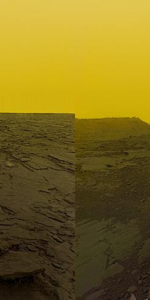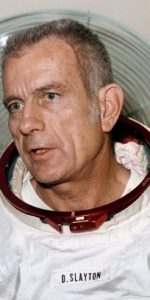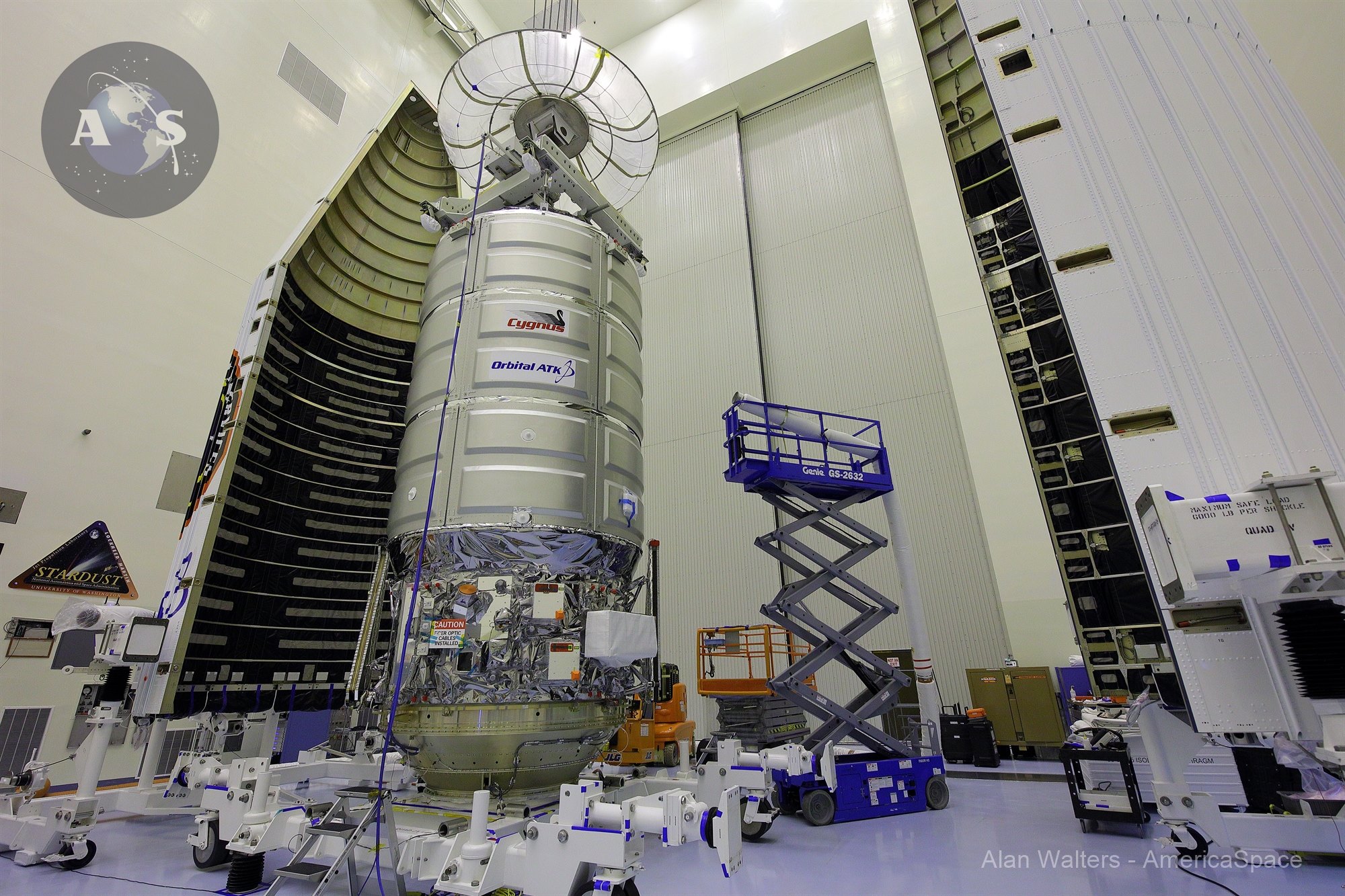
A wide variety of science and technology payloads, ranging from cancer studies to crystal growth and from plant habitats to the deployment of multiple CubeSats, will travel to the International Space Station (ISS) on Orbital ATK’s next Cygnus cargo mission. Earlier this week, payloads co-ordinators, project scientists and principal investigators for the research headed uphill aboard OA-7—currently scheduled to launch no sooner than Sunday, 19 March—gathered to discuss their experiments at a media teleconference. OA-7 marks the third Cygnus spacecraft to be boosted into orbit atop a United Launch Alliance (ULA) Atlas V rocket and, with an anticipated duration of more than three months, this may be the longest resupply mission to date by either of NASA’s commercial partners. In keeping with tradition, the OA-7 Cygnus has been named in honor of an individual who has contributed significantly to human space exploration. In this case, the mission pays tribute to former Project Mercury and shuttle astronaut John Glenn, who died last December.
Although two previous Cygnuses flew aboard Atlas Vs in December 2015 and March 2016, the upcoming OA-7 mission is the first to be executed under ULA’s RapidLaunch architecture. Unveiled last fall, RapidLaunch provides an accelerated hardware schedule for its customers, allowing for payloads to be delivered to orbit as quickly as three months after initial order. Orbital ATK always intended to fly its Cygnuses atop its home-grown Antares booster, but a launch failure of this vehicle in October 2014—and the resultant two-year hiatus which ensued, before it belatedly returned to operational service, last October—caused concern for NASA. The space agency’s need for “enhanced schedule assurance” from its Commercial Resupply Services (CRS) partners led Orbital ATK to contract with ULA in November 2016 to fly OA-7 on an Atlas V.
Liftoff from Space Launch Complex (SLC)-41 at Cape Canaveral Air Force Station, Fla., is presently targeted at the opening of a 30-minute “window”, which opens at 10:56 p.m. EDT on Sunday, 19 March. Under normal circumstances, when flying Antares or SpaceX’s Falcon 9, an “instantaneous” window, timed to the second, is required to establish proper orbital parameters and conditions for ISS rendezvous. However, as detailed previously by AmericaSpace, the flexibility and enhanced performance of the workhorse Atlas V—which recently logged its 70th successful flight—allows for the longer, 30-minute “window”, as well as maximizing the probability of a first-day launch.
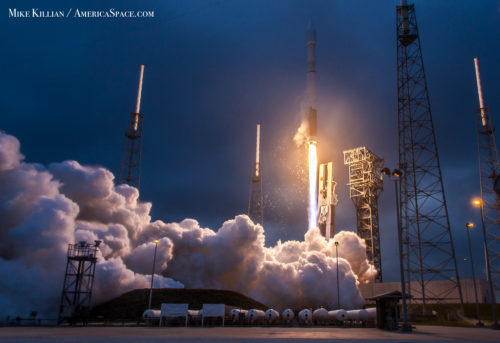
OA-7 is the fourth voyage of Orbital ATK’s “Enhanced Cygnus”, first trialed on the OA-4 mission in December 2015. Based in design upon the shuttle-flown Multi-Purpose Logistics Module (MPLM), this spacecraft benefits from a longer Pressurized Cargo Module (PCM) and can deliver an approximately 60-percent larger haul of supplies to the space station than its predecessor, the Standard Cygnus. Combined with a Service Module (SM), the Enhanced Cygnus stands 15.9 feet (4.86 meters) tall, about 3.9 feet (1.2 meters) higher than the Standard Cygnus, and although their diameters are the same at 10.1 feet (3.1 meters), the Enhanced variant is 4,000 pounds (1,800 kg) more massive and can accommodate a larger payload volume of about 950 cubic feet (27 cubic meters). The Enhanced Cygnus is equipped with lightweight Ultraflex solar arrays, whose characteristic fan-like shape makes the overall “look” of the vehicle distinct to the wing-like appendages of the Standard Cygnus.
The PCM was delivered via flatbed truck to the Space Station Processing Facility (SSPF) at the Kennedy Space Center (KSC) in Florida, in the second week of January, followed by the SM at the end of that same month. By romantic coincidence, the two components were mated together on St. Valentine’s Day. On 23 February, Orbital ATK tweeted that Cygnus was “bagged and ready for transport” to KSC’s Payload Hazardous Servicing Facility (PHSF) for fueling. The spacecraft arrived in the PHSF on 2 March, by which time the integration of the Atlas V Common Core Booster (CCB) and Centaur upper stage was progressing smoothly at the Vertical Integration Facility (VIF) at the Cape’s SLC-41.
One of the key payloads heading uphill on OA-7 is the Advanced Plant Habitat, which was discussed during Monday’s teleconference by Project Scientist Dr. Howard Levine. Designed to enable investigators to better understand the mechanics of plant growth in space, the fully-enclosed habitat—for which a high-fidelity test mockup arrived at KSC last November—will join the ongoing Veggie experiment, which is presently growing fresh food aboard the ISS. Already, small flowering plants related to cabbage and mustard have been grown on Earth in a prototype habitat and will also be grown on-orbit by the Expedition 50 and 51 crews.
The habitat carries more than 180 sensors to measure temperature, oxygen content and moisture levels and, unlike the Veggie hardware, requires relatively little crew time to install, add water and maintain. According to NASA, it is designed to support commercial and fundamental plant research for up to a 135-day science investigation and for at least a year of continuous operation without maintenance. The Advanced Plant Habitat will be installed into a standard EXpedite the PRocessing of Experiments to Space Station (EXPRESS) rack inside Japan’s Kibo laboratory module.
Also destined for an EXPRESS rack location will be Principal Investigator Dr. Sourav Sinha’s ADCs in Microgravity experiment, which will evaluate new Azonafide Antibody-Drug Conjugates (ADCs), combining an immune-activating drug with antibodies to target solely cancerous cells. This is hoped to eventually increase the effectiveness of chemotherapy drugs on Earth, as well as reducing side effects. “In microgravity,” NASA has explained, “cancer cells grow in three-dimensional spheroid structures that closely resemble their form in the human body, allowing for better drug testing. This investigation accelerates development of targeted therapies for cancer patients.” Upon arrival at the ISS, the experiment hardware will be transferred to BioServe’s Space Automated Bioproduct Lab (SABL) unit inside an EXPRESS rack.
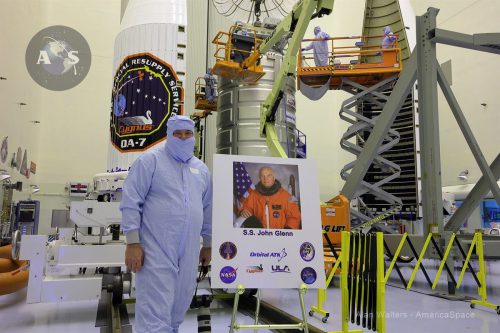
Dr. Glauco Souza of n3D Biosciences, Inc., headquartered in Houston, Texas, will provide a magnetic three-dimensional cell culturing experiment, whose purpose is to use magnetized cells and tools to make it easier to handle cells and cultures and improve the reproducibility of experiments. “The key objective of Magnetic 3D Cell Culture for Biological Research in Microgravity is to validate magnetic cell culturing and bioprinting as a universal platform for two-dimensional and three-dimensional cell culture in space,” NASA outlined recently. “Magnetic cell culture provides the means to more easily manipulate cell cultures in space, thereby paving the way towards the development of new types of tools which may support efficient throughput systems for enhance cell and tissue culture capabilities on-orbit.” The experiment will be transferred to SABL inside an EXPRESS rack.
Dr. Alexei Churilov, senior scientist at Radiation Monitoring Devices, Inc. (RMD), of Watertown, Mass., provided an insight into the Crystal Growth of Cs2LiYCl6:Ce Scintillators in Microgravity (CLYC-Crystal Growth) investigation. This utilizes a new crystal which, for the first time, seeks to effectively detect both gamma rays and neutrons, thereby allowing researchers to better understand the exact conditions needed to produce the highest-quality and defect-free crystals. Described by RMD as “the first practical gamma-neutron scintillation detector for use as a replacement for both medium-resolution gamma ray detectors and Helium-3 proportional counter tubes for neutron detection”, CLYC carries potential applications in homeland security and nuclear non-proliferation, as well as oil and gas exploration, particle and space physics, non-destructive testing and scientific instrumentation.
Another payload aboard Cygnus will be the Thermal Protection Material Flight Test and Re-entry Data Collection (RED-Data-2) experiment, which will evaluate a device to record the extreme thermal conditions encountered by a spacecraft as it descends back into Earth’s atmosphere. About the size of a soccer ball, the RED-Data-2 capsule gathers engineering data during Cygnus’ re-entry and structural breakup at the end of the OA-7 mission. It will test high-temperature materials in actual flight conditions. Under the leadership of Principal Investigator Dr. John Dec, the experiment “increases scientific understanding of how space vehicles breakup during re-entry” and seeks to provide “additional insight to engineers designing vehicles to survive or intentionally be destroyed”.
After Cygnus undergoes thermal breakup, the RED-Data-2 capsule will enter the high-temperature flows to test a pair of new formulations of conformal Thermal Protection System (TPS) material under development by NASA’s Ames Research Center in Moffett Field, Calif. Specifically, these materials are the lightweight Conformal Phenolic Impregnated Carbon Ablator (C-PICA) and Conformal Silicone Impregnated Refractory Ceramic Ablator (C-SIRCA), with a new variant of the Avcoat ablator destined for use on NASA’s Orion spacecraft also under test.
Although ground-based arc-jet tests have been conducted, these are hampered by their inability to simulate a full range of flight regime conditions. Activated no more than 12 hours before Cygnus’ departure from the ISS, RED-Data-2 will collect data on the vehicle’s location, acceleration, temperature, pressure and attitude during re-entry. “Currently, there is little data available to calibrate re-entry models, improve our ability to predict the re-entry breakup process or develop design criteria for future space hardware,” NASA noted, stressing that between 10-40 percent of the total mass of a deorbited satellite or rocket is known to survive atmospheric re-entry, creating “a measurable risk to people and property”.
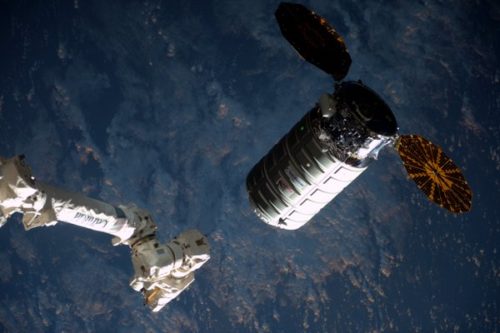
A large flotilla of CubeSats—all belonging to the “one unit” (1U) or “two unit” (2U) size scales, measuring 10x10x10 cm and 20x10x10 cm, respectively—will fly aboard OA-7, according to Henry Martin, external payloads co-ordinator from Houston-based NanoRacks, Inc. In his introductory remarks on Monday, Mr. Martin noted that over 140 CubeSats and over 500 payloads have traveled to the ISS since NanoRacks was founded in 2009 to provide commercial hardware and services to the U.S. National Laboratory aboard the ISS, via a Space Act Agreement with NASA.
The CubeSats flying aboard Cygnus form part of the QB50 campaign, an initiative of the Von Karman Institute in Sint-Genesius-Rode, Belgium, which is funded by the European Commission. This seeks to deliver a total of 50 CubeSats from universities in 19 European universities, ten U.S. universities and others from Japan, Canada and Brazil, for in-situ measurements of Earth’s lower thermosphere, together with re-entry vehicle research. A pair of initial QB50 CubeSats were lofted atop a Dnepr rocket in June 2014, with original plans calling for all 50 to fly aboard a Tsyklon-4 booster in February 2016. However, the unavailability of the latter vehicle led to a decision to accommodate most of the CubeSats aboard OA-7.
In addition to the science payloads, Cygnus will transport a multitude of other hardware, totaling 7,056 pounds (3,202 kg) to the ISS on the OA-7 mission. According to NASA’s Dan Huot, this includes 2,678 pounds (1,215 kg) of vehicle hardware, 2,100 pounds (954 kg) of crew supplies, 2,072 pounds (940 kg) of utilization payloads, 4.4 pounds (2 kg) of computer resources and 39 pounds (18 kg) of equipment for the station’s Russian Orbital Segment (ROS). Additionally, about 160 pounds (73 kg) of Extravehicular Activity (EVA) equipment—specifically, Extravehicular Mobility Unit (EMU) leg assemblies, boots, arm-sleeves, a toolkit, tether extensions and support tools—will be aboard.
Up to three U.S. EVAs are penciled-in for the March timeframe, to support the detachment and relocation of Pressurized Mating Adapter (PMA)-3 from its current perch on the Tranquility node to its final Commercial Crew location on the space-facing (or “zenith”) interface of the Harmony node. PMA-3 will eventually be outfitted with a Boeing-built International Docking Adapter (IDA) and will serve as a backup port for the CST-100 Starliner and Crew Dragon vehicles. Noting that the EVA equipment aboard Cygnus includes “nothing vital for the upcoming EVAs”, Mr. Huot told AmericaSpace that “dates, content and spacewalkers still being finalized”, but that “PMA-3 relocation would take place approximately two days after the first spacewalk to disconnect the adapter is completed”. In readiness for the impending tasks, the Expedition 50 crew recently removed items stored inside PMA-3, as well as the Intermodular Ventilation (IMV) valve which links it to the Tranquility node.
With the rendezvous and capture of Cygnus anticipated about three days after launch, Expedition 50 Commander Shane Kimbrough will be at the controls of the 57.7-foot-long (17.6-meter) Canadarm2 robotic arm, assisted from inside the space station’s multi-windowed cupola by Flight Engineer Thomas Pesquet. In their four months together, the pair have worked together to capture and berth or unberth and release Orbital ATK’s OA-5 Cygnus, Japan’s H-II Transfer Vehicle (HTV) and last month’s CRS-10 Dragon. If the OA-7 mission flies on time, it should be Kimbrough’s final visiting vehicle; he is due to return to Earth on 10 April, aboard Soyuz MS-02, with his Russian crewmates Sergei Ryzhikov and Andrei Borisenko, wrapping up a six-month increment.
Be sure to “LIKE” AmericaSpace on Facebook and follow us on Instagram & Twitter!
Missions » ISS » COTS » CYGNUS »



